27
Introduction
Many objects in our daily life are related to resistors, but some are very large and some are very small. The resistor we are talking about here is a resistor in an electronic device, but the resistor is often referred to as a resistor. Resistor is almost an indispensable part of any electronic circuit. As the name implies, the role of the resistor is to block the action of electrons. The main functions in the circuit are: buffering, load, voltage division and shunt, protection and so on.
The resistance value of the resistance element is generally related to temperature, material, length, and cross-sectional area. The physical quantity that measures the magnitude of the resistance of the resistance is the temperature coefficient, which is defined as the percentage change of the resistance value for every 1℃increase in temperature. The main physical characteristic of a resistor is that it converts electrical energy into thermal energy. It can also be said that it is an energy-consuming component through which current is generated to generate internal energy. The resistor usually functions as a partial pressure or a shunt in the circuit. For signals, both AC and DC signals can pass through the resistor.
Catalog
Introduction | |
I The Functions of Resistor | 1.1 Current-limiting |
1.2 Current Shunt | |
1.3 Current Division | |
II The Compositions of Resistor | |
III The Basic Principles of Resistor | |
IV The Classifications of Resistor | 4.1 Classification by Resistance Characteristics |
4.2 Classification by Shape | |
4.3 Classification by Manufacturing Materials | |
4.4 Classification by Installation Method | |
4.5 Classification by Functions | |
4.6 Classification by Lead Wire | |
V Characteristics and Applications of Common Resistors | 5.1 Carbon Film Resistor |
5.2 Metal Film Resistor | |
5.3 Precision Metal Film Resistor | |
5.4 Wirewound Resistor | |
5.5 Insurance Resistor | |
5.6 Cement Resistor | |
5.7 Zero Ohm Resistor | |
5.8 Network Resistor | |
5.9 Thermal Resistor | |
VI The Development trend of Resistors | |
I The Functions of Resistor
The obstruction effect of an object on the passage of current is called a resistance, and the element made by such an obstruction is called a resistor, and is simply referred to as a resistor.
Resistor is the most widely used type of circuit components, accounting for more than 30% of the total number of components in electronic devices. The quality of the resistors has a great impact on the stability of the circuit. In the circuit, the main function of resistors is to stabilize and regulate the current and voltage in the circuit, that is, to reduce voltage, divide voltage, limit current, shunt, isolate, filter (with capacitors), match and signal amplitude adjustment.
1.1 Current-limiting
In order to ensure that the current through the appliance does not exceed the rated value or the required value for actual operation to ensure the normal operation of the appliance, it is usually to series a variable resistor in the circuit. When the resistance is changed, the magnitude of the current also changes. We call this resistor, which can limit the magnitude of the current, a current limiting resistor.
1.2 Current Shunt
When several electrical appliances with different rated currents need to be connected to the main circuit at the same time, a resistor can be connected in parallel at both ends of the electrical device with a small rated current, which acts as a "shunt".
1.3 Current Division
The general electrical appliances are marked with the rated voltage value. If the power supply is higher than the rated voltage of the electrical appliance, the electrical appliance should not be directly connected to the power supply.
In this case, the appliance can be connected in series with a resistor of suitable resistance to share a portion of the voltage, and the appliance can operate at the rated voltage. We call such a resistor a divider resistor.
II The Compositions of Resistor
It refers to a two-terminal electronic component made of a resistive material and having a certain structure and capable of limiting current flow in the circuit. A resistor whose resistance cannot be changed is called a fixed resistor, and a variable resistance is called a potentiometer or a variable resistor. The ideal resistor is linear, that is, the instantaneous current of the resistor is proportional to the applied instantaneous voltage. Some special resistors, such as a thermistor, a varistor and a sensitive element, are non-linear in relation to the current. Resistors are the most widely used components in electronic circuits. They are usually formed in different series according to power and resistance for circuit designers to choose. They are mainly used in the circuit to regulate and stabilize the current and voltage. They can also be used as a shunt and a voltage divider, or as a circuit matching load. Depending on the circuit requirements, they can also be used for negative feedback or positive feedback of amplifying circuits, voltage-current conversion, voltage or current protection components for input overload, and RC circuits for oscillation, filtering, bypassing, differentiation, integration, and time. Constant elements, etc.
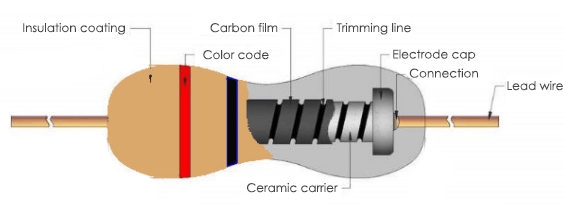
III The Basic Principles of Resistor
The resistor is composed of three parts: resistor, skeleton and lead-out end (the resistor and skeleton of solid core resistor are combined into one), and the resistance value is determined only by the resistor. For a resistor with a uniform cross section, the resistance value is

ρ is the resistivity of the resistive material (ohm·cm)
L is the length of the resistor body (cm)
A is the cross-sectional area of the resistor (square centimeter)
The thickness d of the thin film resistor is small, it is difficult to measure, and ρ varies with the thickness, so it is regarded as a constant related to the film material, which is called film resistance. In fact, it is the resistance of a square film, so it is also called square resistance (ohm/square).

W is the width of the film (cm). Usually Rs should be within a limited range, and Rs will affect the stability of the resistor performance if it is too large. Therefore, the cylindrical resistor body is grooved and the planar resistor body is used to etch the meandering pattern to expand the resistance range and perform fine adjustment of the resistance.
IV The Classifications of Resistor
4.1 Classification by resistance characteristics:
fixed resistor, adjustable resistor, special resistor (sensitive resistor).
4.2 Classification by shape:
cylindrical resistor, button resistor, SMD resistor and so on.
4.3 Classification by manufacturing materials:
thin-film resistor(carbon film resistance, metal film resistance, metal oxide film resistance, synthetic film resistance), wirewound resistor, cement resistor and so on.
4.4 Classification by Installation Method:
plug-in resistor and SMD resistor.
4.5 Classification by functions:
load resistor, sampling resistor, shunt resistor, protective resistor and so on.
4.6 Classification by lead wire:
axial lead resistor and non-lead resistor.
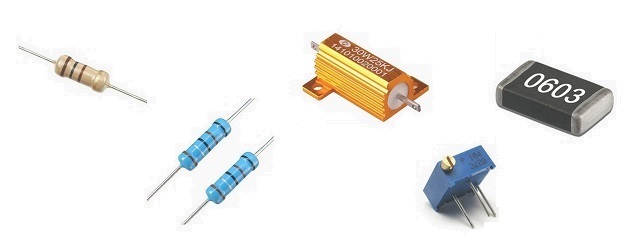
V Characteristics and Applications of Common Resistors
5.1 Carbon Film Resistor
The carbon film resistor is one of the film resistors. It uses high-temperature vacuum coating technology to attach carbon to the surface of the ceramic rod to form a carbon film, and then cut it with a suitable joint, and the surface is coated with epoxy resin to protect it. The surface is often coated with a green protective lacquer. The thickness of the carbon film determines the magnitude of the resistance, and the thickness of the control film and the groove are usually used to control the resistor. Carbon film resistance is also called "thermal decomposition carbon film resistance". It is a thin film resistor in which a hydrocarbon thermally decomposes at a high temperature in a vacuum deposits on a substrate.
Features
(1) Accuracy: 2%~5%, high precision, precision resistors can be made by adjusting the resistance value of the film cutting thread.
(2) Resistance range: it is wide, generally 2.1Ω~10MΩ.
(3) Nominal resistance: E-48.
(4) High limit voltage.
(5) Excellent long-term stability, the change of voltage has little effect on the resistance value, and has a negative temperature coefficient.
(6) It has good high frequency characteristics and can be made into high frequency resistors and ultra-high frequency resistors with low inherent noise EMF below 10UV/V.
(7) The pulse load is stable and the adaptability to the pulse is good. It is widely used in AC, DC and pulse circuits.
Applications
Carbon film resistors used to be the most used resistors for electronics, electrical appliances, and information products. They are the cheapest and have high reliability of quality stability. Because it is a leaded resistor, it is easy to install and repair by hand, and it is also the cheapest of the lead resistors. It is now used in low-end products such as power supplies and adapters or early design products.
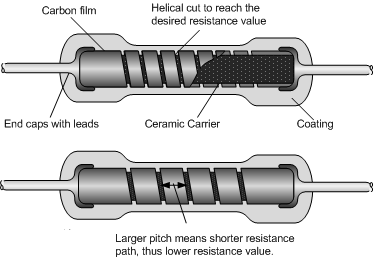
5.2 Metal Film Resistor
The metal film resistor is made by depositing a layer of alloy powder on a porcelain substrate under vacuum. Different resistance values can be obtained by changing the thickness or length of the metal film. Metal film resistors mainly include the CN, the RS and the RK.
Its heat resistance, noise potential, temperature coefficient, voltage coefficient and other electrical properties are superior to carbon film resistors. The manufacturing process of the metal film resistor is relatively flexible. It can not only adjust its material composition and film thickness, but also adjust its resistance value by grooving, so it can be made into resistor with good performance and wide resistance range.
Features
(1) High heat conduction porcelain core.
(2) Highly stable metal film.
(3) Good press fit: high reliability end cap.
(4) High insulation.
(5) MIL&EIA compliant: standard color code.
(6) Good soldering wire.
Applications
Compared with carbon film resistance, this kind of resistance is small in size, low in noise and good in stability, but its cost is high. It is widely used as a precision and high stability resistor, and is also widely used in various radio electronic devices.
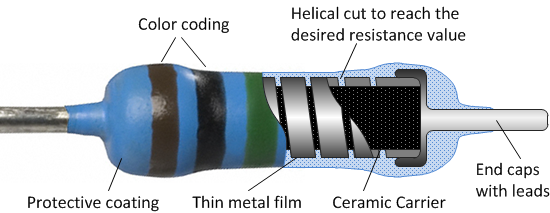
5.3 Precision Metal Film Resistor
It is made of nickel-chromium or similar alloys tightly attached to the surface of ceramic rods by high temperature vacuum coating technology. After cutting and debugging the resistance value, the final required precision resistance value can be achieved. Then appropriate joints are cut and epoxy resin is coated on the surface to protect it.
Features
(1) Advanced thin film technology.
(2) Low temperature coefficient.
(3) Good heat dissipation.
(4) Superior overall stability.
(5) High performance and low cost.
Applications
Because it is a lead-type resistor, it is convenient for manual installation and maintenance, and is used in most home appliances, communication, and instrumentation.
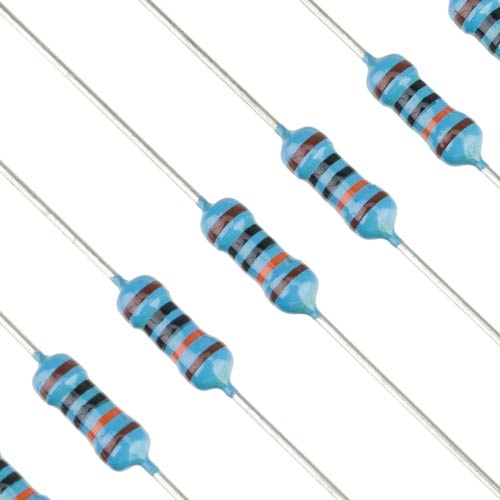
5.4 Wirewound Resistor
The wirewound resistor is made of nickel-chromium wire, manganese-copper wire and constantan wire on the porcelain tube, and is divided into fixed type and adjustable type. Common winding resistors include cement resistors, safety resistors, etc.
Features
(1) Non-flammable winding coating resistor.
(2) High pressure resistant.
(3) Fast heat dissipation.
(4) Excellent overload performance in short time.
(5) Low noise.
(6) Resistance value does not change over the years.
Applications
It is mainly used in low-frequency AC circuit to play the role of voltage reduction, shunting, load, feedback, energy conversion, matching, or in the power supply circuit to play the role of absorber and voltage divider, can also be used as oscillation circuit and transformer attenuation adjustment and pulse forming circuit shunt. In addition, it can also be used for discharge and spark suppression of filter stage capacitors in rectifiers. At the same time, it can be widely used in home appliances, medical equipment, automotive industry, railway, aviation, military equipment and other fields.
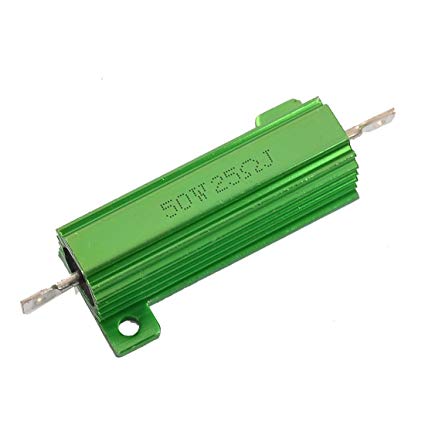
5.5 Insurance Resistor
The insurance resistor is also known as the fuse resistor. The fuse resistor has the function of both the resistor and the fuse. It is usually used only as a resistor. Once the current is too large, the fuse is used to protect the machine. The patch fuse resistor is usually green in color and has a white number "000" or current rating. When the circuit load is short-circuited and overcurrent occurs, the temperature of the fuse resistor will rise to 500 ~600 C in a very short time. At this time, the resistive layer is blown off by heat and acts as an insurance to achieve the purpose of improving the safety of the whole machine.
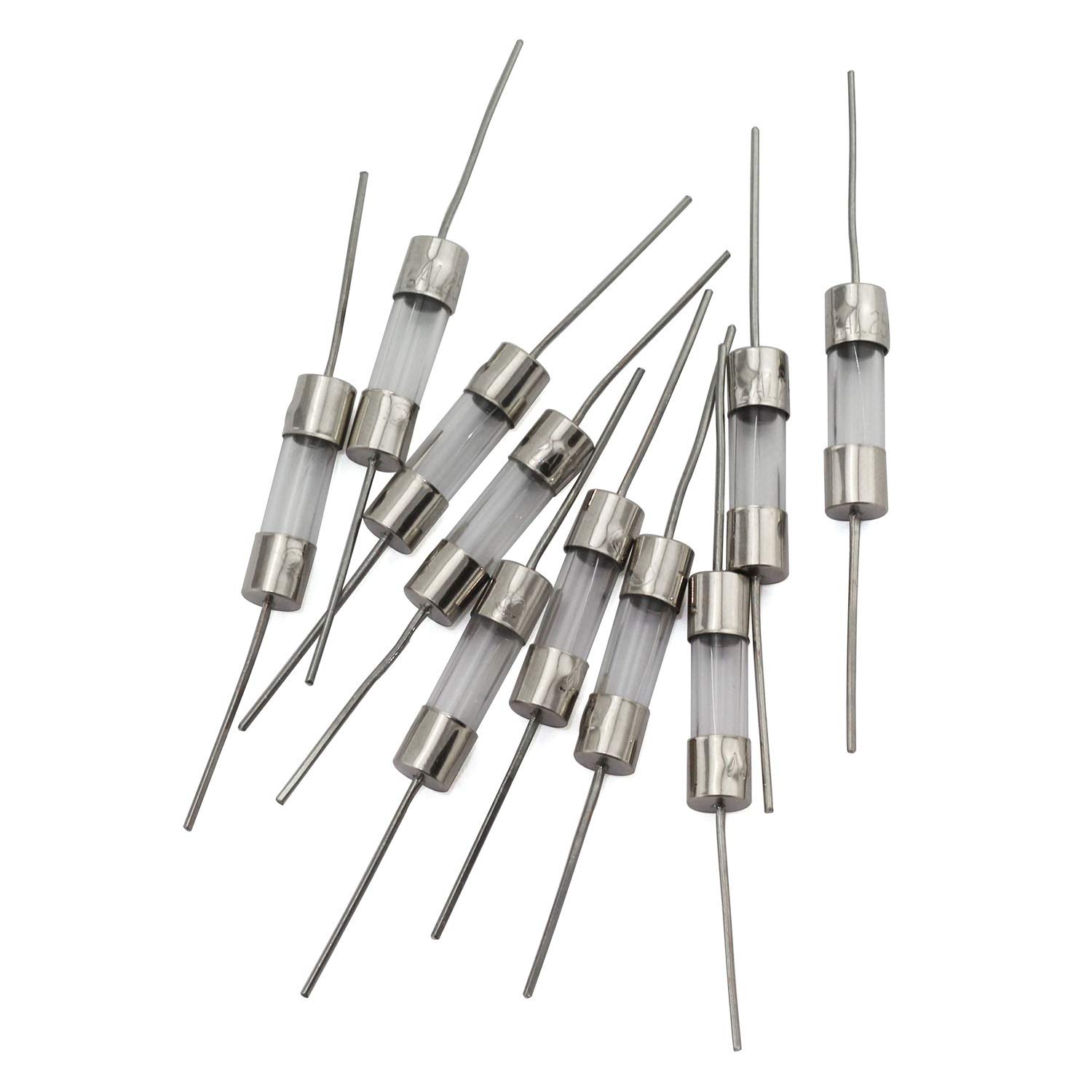
5.6 Cement Resistor
The cement resistor is also a kind of fuse resistor, which is wound around a heat-resistant porcelain piece and protected by heat-resistant, moisture-resistant and corrosion-resistant materials. The cement resistor is formed by placing the resistor body in a rectangular porcelain frame and filling it with a special non-combustible heat cement. It quickly blows when the circuit is overcurrent to protect the circuit.
Features
(1) Shock-resistant, moisture-resistant, heat-resistant, good heat dissipation and low price.
(2) Fully insulated, suitable for printed circuit boards.
(3) The ceramic rod is wound on the wire and then welded to the joint to produce accurate resistance values and prolong life.
(4) The high resistance value is made of the MO instead of a winding method.
(5) Super heat dissipation, small linear temperature coefficient.
(6) Excellent overload performance in short time, low noise and resistance value does not change over the years.
(7) Good explosion-proof performance to protect.
Applications
Cement resistors are usually used for large power and high current. There are 2W, 3W, 5W, 10W or even more power. The appliances such as air conditioners and TV sets with power above 100W will basically use cement resistors.
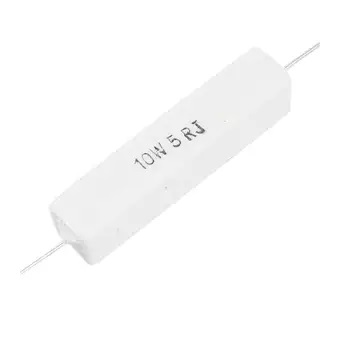
5.7 Zero Ohm Resistor
The zero ohm resistor, also known as the jumper resistor, is a special purpose resistor. Its resistance value is not zero, it is actually a resistor with a small resistance. Because of its resistance value, it has the same error accuracy as conventional chip resistors. In the design of the circuit board, two points cannot be connected by printed circuit, and the cross-line connection is often used on the front side. This is often seen in ordinary boards. In order to make the automatic placement machine and the automatic plug-in machine work normally, zero resistance is used instead of the cross-line.
Functions
(1) There is no function in the circuit, just for the convenience of debugging or compatible design on the PCB.
(2) It can be used as jumper to avoid high frequency interference caused by jumper.
(3) When the matching circuit parameters are uncertain, replace them with zero ohm resistor. When the actual debugging is performed, the parameters are determined and replaced with specific numerical components.
(4) The zero ohm resistor is actually a resistor with a small resistance value. When measuring the current consumption of a certain part of the circuit, remove the zero ohm resistor and connect the ammeter, which is convenient for measuring current consumption and large current.
(5) Can add a zero ohm resistor in the wiring.
(6) Acts as an inductor or capacitor under high frequency signals.
(7) Single-point grounding: refers to the protection grounding, working grounding and DC grounding are separated from each other on the equipment and become independent systems.
(8)Used for current loops when crossing. When the ground plane is divided, the shortest return path of the signal is broken. At this time, the signal loop has to be detoured to form a large loop area, and the influence of the electric field and the magnetic field becomes stronger, which is easy to interfere/interfered. By connecting a zero ohm resistor across the partition, a shorter return path can be provided to reduce interference.
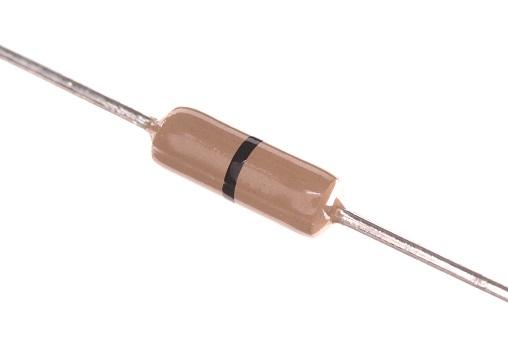
5.8 Network Resistor
Network resistor is the wire-wound resistor. It is a combination of several resistors with exactly the same parameters. One of their pins is connected together as a common pin. The remaining pins are normally drawn out. So if a network resistor is made up of n resistors, then it has n + 1 pins. Generally speaking, the one on the left is the public pin. It is usually marked with a color point on the exclusion. The network resistor has the advantages of convenient assembly and high installation density, and has been widely used in televisions, monitors, computer motherboards, and small appliances. Network resistor usually has a common end, which is represented by a small white dot on the packaging surface. Its color is usually black or yellow.
Applications
Network resistor is generally used in digital circuits, instrumentation circuits and computer circuits, such as the attenuator in instrumentation circuits. It is more convenient to use an array of resistors than to use several fixed resistors.
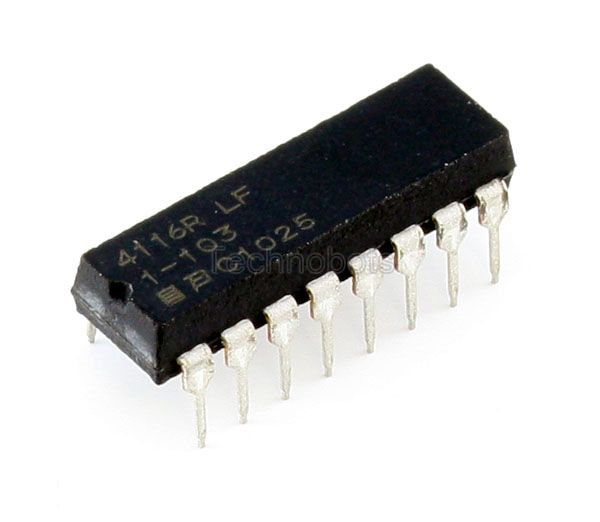
5.9 Thermal Resistor
The thermistor is a type of sensitive component and is divided into a positive temperature coefficient thermistor (PTC) and a negative temperature coefficient thermistor (NTC) according to the temperature coefficient. Thermistor is typically temperature sensitive and exhibits different resistance values at different temperatures.The positive temperature coefficient thermistor (PTC) has a higher resistance value at higher temperatures, and the resistance value of the negative temperature coefficient thermistor (NTC) is lower at higher temperatures. They belong to the semiconductor device.
Features
(1) The sensitivity is high.The temperature coefficient of resistance is 10 - 100 times larger than that of metal, and the temperature change of 10-6℃ can be detected.
(2) The working temperature range is wide. The normal temperature device is suitable for -55℃~315℃. The high temperature device is suitable for temperature higher than 315℃ (up to 2000℃ at present), and the low temperature device is suitable for -273℃~-55℃.
(3) It is small enough to measure the temperature of voids, cavities and blood vessels that other thermometers cannot measure.
(4) It is easy to use, the resistance value can be arbitrarily selected from 0.1 to 100kΩ.
(5) It can be easily processed into complex shapes and can be produced in large quantities.
(6) Good stability and strong overload capacity.
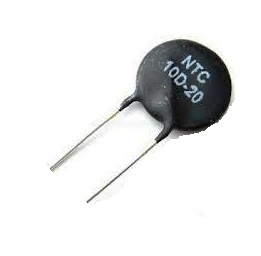
VI The Development trend of Resistors
(1) Miniaturization and high reliability.
(2) Separate small resistors still have a wide range of uses, but will further reduce the size, improve performance and lower prices.
(3) Carbon film resistors are still dominant in consumer electronics products, while metal film resistors will be dominant in precision resistors, and most low-power wire wound resistors will be replaced.
(4) In order to adapt to the development of circuit integration and planarization, the need for chip resistors will increase significantly; the universal type will tend to develop thick film resistors, while precision type will still tend to metal films and metal foils in film types.
(5) Develop the combined resistor network.
You May Also Like:
The Pull-up Resistor and Pull-down Resistor
What is the giant magnetoresistance (GMR)?
How to Test Ground Resistance?
What Are the Functions and Applications of the Varistor?
Ordering & Quality
| Photo | Mfr. Part # | Company | Description | Package | Qty |
|
MC68376BACAB25 | Company:NXP / Freescale | Remark:IC MCU 32BIT 160QFP | Package:QFP |
MC68376BACAB25 Datasheet |
In Stock:78 Inquiry |
Inquiry |
|
MAX4507EAP | Company:Maxim Integrated | Remark:IC SIGNAL LINE PROTECTOR 20-SSOP | Package:20-SSOP (0.209", 5.30mm Width) |
MAX4507EAP Datasheet |
In Stock:2254 Inquiry |
Inquiry |
|
MC68882CFN25A | Company:NXP | Remark:- | Package:PLCC68 |
MC68882CFN25A Datasheet |
In Stock:115 Inquiry |
Inquiry |
|
P89LPC9361FDH518 | Company:NXP | Remark:P89LPC9361FDH518, NXP, Embedded - Microcontrollers | Package:28-TSSOP (0.173", 4.40mm Width) |
P89LPC9361FDH518 Datasheet |
In Stock:118 Inquiry |
Inquiry |
|
MCF51JM32VLK | Company:NXP | Remark:IC MCU 32BIT 32KB FLASH 80LQFP | Package:80-LQFP |
MCF51JM32VLK Datasheet |
In Stock:113 Inquiry |
Inquiry |
|
Z8F042ASB020EG | Company:ZiLOG | Remark:IC MCU 8BIT 4KB FLASH 8SOIC | Package:8-SOIC (0.154", 3.90mm Width) |
Z8F042ASB020EG Datasheet |
In Stock:802 Inquiry |
Inquiry |
|
CM2020-00TR | Company:ON Semiconductor | Remark:IC HDMI TX PORT P/I 38-TSSOP | Package:38-TFSOP (0.173", 4.40mm Width) Exposed Pad |
CM2020-00TR Datasheet |
In Stock:183990 Inquiry |
Inquiry |
|
MAX1490AEPG+ | Company:MAXIM | Remark:IC RS485/RS422 DATA INTRFC 24DIP | Package:PDIP-24 |
MAX1490AEPG+ Datasheet |
In Stock:8428 Inquiry |
Inquiry |
|
MAX6805US26D3+T | Company:Maxim Integrated | Remark:IC RESET MPU LOW PWR SOT143-4 | Package:TO-253-4, TO-253AA |
MAX6805US26D3+T Datasheet |
In Stock:4060 Inquiry |
Inquiry |
|
UPSD3212CV-24U6 | Company:STMicroelectronics | Remark:IC MCU 8BIT 80KB FLASH 80TQFP | Package:TQFP80 |
UPSD3212CV-24U6 Datasheet |
In Stock:1200 Inquiry |
Inquiry |